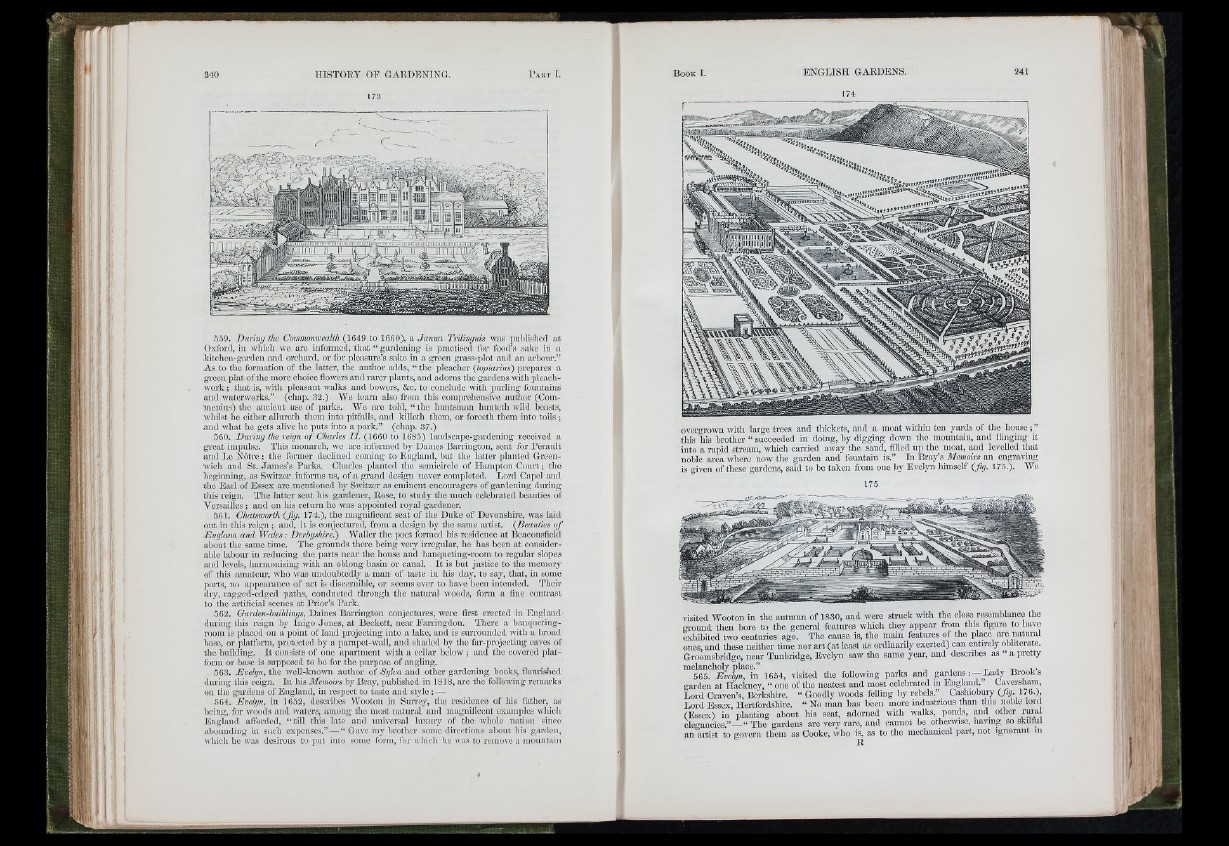
5.59. During ihe Commonwealth (\6A6 to 1660), a Janua Trilinguis was piibli.shcd at
Oxford, iu Avliicli wc arc informed, that “ gardening is practised for food’s sake in a
kitchen-garden and orchard, or for pleasure’s sake in a green grass-plot and. an arbour.”
As to the foi’mation of the latter, the author adds, “ the pleaclier (topiarius) prciiares a
gi-ccn plat of tlic more choice floivcrs and rarer plants, and adoms the gardens with pleach-
work ; that is, with i)lcasant walks and bowers, &c. to conclude with purling fountains
and Avatcnvorks.” (chap. 32.) Wc learn also from this comprehensive author (Com-
inenius) the ancient use of parks. Wc are told, “ the huntsman liunteth wild beasts,
whilst he cither alliireth them into pitfalls, and killeth them, or forccth them into toils ;
an d what ho gets alive he puts into a park.” (chap. 37.)
560. During the reign o f Charles I I . (1660 to 1685) landscape-gardening received a
great impulse. This monarch, wc arc informed hy Daines Ban-ington, sent for Pcrault
and Lc Notre : the former declined coming to England, but the latter planted Green-
Avicli and St. James’s Parks. Charles planted the semicircle of Hampton Court ; tlio
beginning, as Switzer informs us, of a grand design never completed. Lord Capel and
the Earl of Essex are mentioned by Switzer as eminent cncouragcrs of gai-dcning during
this reign. The latter sent his gardener, Rose, to study the much celebrated beauties of
Versailles ; and on his return he was appointed royal gardener.
561. Chatsworth (fig. 174.), the magnificent seat of the Duke of Devonshire, was laid
out in this reign ; and, it is conjectured, from a design by the same artist. (Beauties o f
Englana and Wales : Derhjshire.) Waller the poet formed his residence at Bcaconsfield
about the same time. The grounds there being very irregular, he has been at considerable
labour in reducing the jiarts near the house and baiiqueting-room to regular slopes
and levels, harmonising with an oblong basin or canal. I t is but justice to the memory
of this amateiu', avIio was undoubtedly a man of taste iu his day, to say, that, in some
parts, no appearance of a rt is discernible, or seems ever to have been intcndc<l. Their
dry, raggcd-cdged paths, conducted through the natiu-al woods, form a fine contrast
to the artificial scenes at Prior’s Park.
562. Garden-huildings, Daines Barrington conjectures, were first erected in England
during this reign by Inigo Jones, at Beckett, near Farringdon. Tlicrc a bancpicting-
room is placed on a point of land projecting into a lake, and is sun-ounded with a broad
base, or jilatfonn, protected by a parapct-wall, and shaded hy the far-projceting caves of
the building. I t consists of one apartment with a cellar below ; and the covered platform
or base is supposed to be for the purpose of angling.
563. Evelyn, the well-known author of Sylva and other gardening books, flourisJicd
during this reign. In his Memoirs by Bray, published in 1818, are the following remarks
on the gardens of England, in respect to taste and style : —
564. Evelyn, in 1652, describes Wooton in Sun-ey, the residence of his father, as
being, for woods and waters, among the most natural and magnificent examples whicli
England aftordcd, “ till this late and universal luxury of the ivhole nation since
abounding in such expenses.”—'“ Gave my brother some directions aliuut his ganleii,
Avliich he was desirous to put into some form, for which lie was to remove a mouiitaiu
ovcrgi'own with large trees and thickets, and a moat witliin ten yards of the house ; ”
this his brother “ succeeded in doing, by digging down the mountain, and flinging it
into a rapid stream, which cai-ried away the sand, filled np the moat, and levelled that
noble area where now the garden and fountain is.” In Bray’s Memoirs an cngi-aving
is given of these gardens, said to be taken from one by Evelyn liimself (fig. 175.). We
visited Wooton in the autumn of 1830, and were struck Avith the close resemblance the
ground then bore to the general features which they appear from this figm-e to have
exhibited two centuries ago. The cause is, the main featm-es of the place are natimal
ones, and these neither time nor a rt (a t least as ordinarily exerted) can entirely obliterate.
Groomsbridge, near Tunbridge, Evelyn saw the same year, and describes as “ a pretty
melancholy place.” , .
565. Evehjn, in 1654, visited tho following parks and gard en s:— Lady Brooks
garden at Hackney, “ one of the neatest and most celebrated in England. Cawershara,
Lord Craven’s, Berkshire. “ Goodly woods felling by rebels.” Cashiobury (yip. 176.),
Lord Essex, Hertfordshire. “ No man has been more industrious than tins noble lor(l
(Essex) in planting about his seat, adorned with walks, ponds, and other rural
elegancies.”— “ The gardens arc very rare, and cannot he otherwise, having so skilful
an artist to govern them as Cooke, Avho is, as to the mechanical part, not ignorant m
R
■I
‘ I